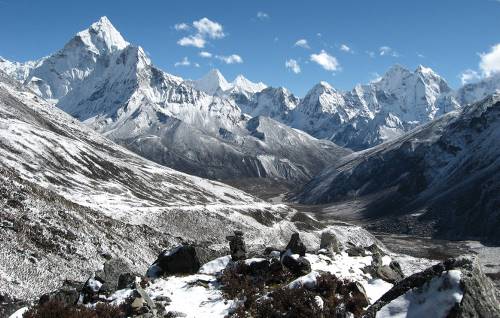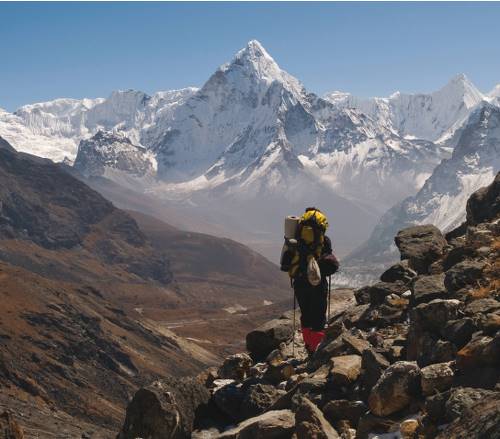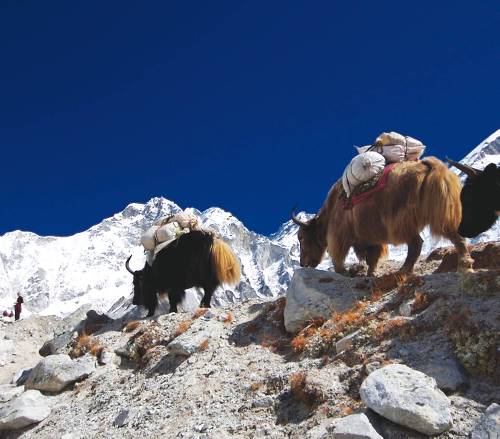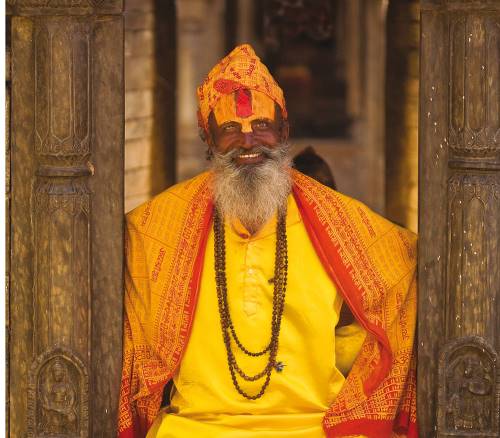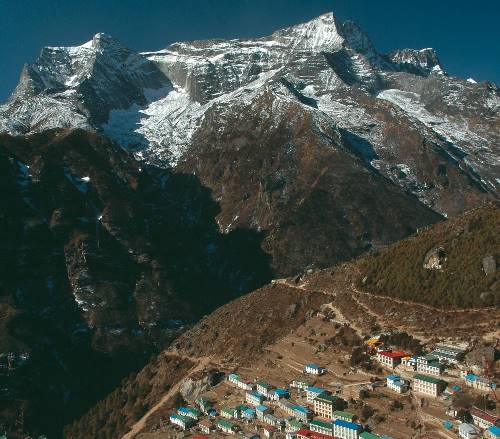Everest Base Camp over 55's in Comfort
Everest Base Camp over 55's in Comfort
$3160
Tour Overview
Embark on an unforgettable adventure with the "Everest Base Camp over 55's in Comfort" tour, designed for those seeking a well-paced trek through the breathtaking landscapes of Nepal. This journey offers ample acclimatization days, allowing you to fully appreciate the majestic views of Mt. Everest from Kala Pattar at 5545m. Experience the vibrant Sherpa culture in Namche Bazaar and immerse yourself in the spiritual ambiance of Thyangboche Monastery. Trek through historic Sherpa villages like Khunde and Khumjung, home to Sir Edmund Hillary's school and hospital. Enjoy a scenic flight to Lukla and explore the bustling city of Kathmandu. With comfortable accommodations in eco-lodges and private camps, expert guides, and all meals included, this adventure ensures a memorable and enriching experience in the heart of the Himalayas. ...more ...less
Highlights
Itinerary
Day 1 : Join Kathmandu
Location: Kathmandu
Accommodation Name: Radisson Hotel
Meals Included: Dinner
You will be met by a representative of World Expeditions and transferred to the Radisson hotel. Remainder of the afternoon at leisure. A pre-trek briefing will be given around 4.30-5pm where arrangements will be made for the distribution of your kit bag, sleeping bag and down/fibrefill jacket. This evening we will head out for dinner, this is a great opportunity to get acquainted with your fellow group members.
Overnight: Radisson Hotel ...more ...less
Day 2 : Free day or drive to Ramechap (approx 5 hours)
Location: Dhulikhel, Ramechap
Accommodation Name: Private eco-camp
Meals Included: Breakfast, Lunch
After breakfast there will be an opportunity to pick up any last minute trekking items before departing to Ramechap. We will journey through foothills and valleys before stopping at Dhulikhel for lunch. After lunch we continue to Ramechap, a small town that operates flights to Lukla, the starting point of all treks in the Khumbu region. Our campsite will be in close proximity to the runway for our early morning flight to Lukla.
Overnight: Private eco-camp
*NB: Domestic flights to/from Lukla during Spring and Autumn trekking seasons (March-May and October-December) may operate from Manthali Airport, Ramechap. This is determined by the Civil Aviation Authority of Nepal and dates are subject to change. Your leader will brief you on flight arrangements locally.
Day 3 : Fly Lukla (2800m). Trek to Ghat (2530m). Walk approx 2 hours
Location: Lukla, Ghat
Accommodation Name: Private eco campsite
Meals Included: Breakfast, Lunch, Dinner
We transfer to the airport for the 45 minute flight to the STOL airstrip at Lukla. This was the airstrip built by Sir Edmund Hillary and his friends to service the Everest Region when he began his work of building schools and hospitals for the Sherpa people. It is a memorable flight, with marvellous views of the Eastern Himalaya. At Lukla we are immediately impressed by the scale of the huge peaks that surround the village but this is only a foretaste of what is to come. Our crew assemble and we head downhill towards the Dudh Kosi, a raging river that flows from the highest peaks. The broad and well-marked trail meanders around fields of potatoes and buck-wheat and passes through small villages, as we pass rows of tree dahlia to make our way to our first overnight stop at our private eco campsite at Ghat.
Day 4 : To Monjo (2850m). Walk approx 4-5 hours
Location: Dudh Kosi River, Kusum Kangru, Nupla, Kongde Ri, Thamserku, Monjo
Accommodation Name: Private eco camp site
Meals Included: Breakfast, Lunch, Dinner
Today we cross and re-cross the thundering glacial river, named "Dudh" (milk) Kosi (river) because of its colour. Sections of today's walk are through pine forest and cleared areas reveal terraced fields and a variety of crops. We pass small groups of donkeys and yaks carrying trading goods and trek-gear along the trail. We pass small groups of donkeys, yaks and dzopko carrying trading goods and trek - gear along the trail. A dzopko is a yak-cow crossbreed while a yak is a full-blood long haired male, more commonly found at higher altitudes. Spectacular mountain peaks unfold above us and seem to hover above the tree-line as they rise above the deep river valley. Shortly after leaving camp we cross the Kusum Khola, a tributary stream to the Dudh Kosi, and the peak of Kusum Kangru (6369 m) can be seen to the East, at the head of the valley. Further along the trail, across the valley to the North-West, Nupla (5885 m) and Kongde Ri (6093 m) rise above the forested ridges. At a turn of the trail, Thamserku (6808 m) rises majestically, seemingly from the river floor.
We will see our first Mani walls today. These stone structures are a compilation of many stone tablets, each with the inscription "Om Mani Padme Hum" which translates to "Hail to the jewel in the lotus", and is mantra (chant) venerated by Buddhists and Brahmans alike.
Buddhists will walk to the left of these Mani Walls and chortens, but you may notice that people of the lowlands who have no knowledge of Buddhism do not follow this practice.
The allure of the mountains is hard to resist, but we must be patient, as it is very important to acclimatise slowly and thereby fully appreciate our time at higher altitude. Today's walk is not a long one, and you will be eager to press on. Slow down, and enjoy the journey. Overnight at our private eco camp site above Monjo.
Day 5 : To Namche (3440m). Walk approx 4-5 hours
Location: Sagarmatha National Park, Namche Bazaar
Accommodation Name: Eco-lodge
Meals Included: Breakfast, Lunch, Dinner
This morning we cross the green/aqua waters of the Dudh Kosi and pass through the gates of the Sagamartha National Park. The establishment of this national park is a significant attempt to stem the use of fire-wood in the area. Self-contained trek groups must use only kerosene fuels for cooking, a philosophy we follow everywhere in Nepal, whether we are in a national park or not. Tea-houses and lodges are encouraged to use kerosene, yak dung or electricity but unfortunately continue to use mostly fire-wood for cooking, heating and for hot water for trekker's showers. This practice continues to deplete the forests. We follow the river course to the confluence of the Dudh Kosi and the Bhote Kosi and cross a spectacular high bridge before commencing our ascent to the village of Namche Bazaar, the Sherpa "capital" of Nepal. It is a tough climb as the trail passes through forest of pine to a vantage point that provides our first view of Mt Everest. The trail continues to climb and meander to Namche and the sight of this prosperous village spread within a horse-shoe shaped valley opposite the beautiful peak of Kongde Ri is worth every step. After lunch you may wish to peruse the Tibetan trader's stalls or the Sherpa shops in search of a bargain.
Overnight: eco-lodge
Day 6 : Rest day Namche Bazaar
Location: Namche Bazaar, Sagarmatha National Park, Everest View Hotel, Khumjung
Accommodation Name: Eco-lodge
Meals Included: Breakfast, Lunch, Dinner
Sagarmartha National Park Headquarters just above our private eco campsite offers a very interesting display of photographs, memorabilia and information on the park, and the hill above is a wonderful vantage point for the spectacular view up the Imja Khola Valley towards Everest. The change from the narrow lowland valleys to the broad glacial ones is immediately obvious. The steep-sided glacial valley before us gradually winds towards the base of Everest, broken only by the moraines left by retreating glaciers. Its more gradual rate of climb is a blessing for those trekking higher. Towering to over 4000 metres above the valley floor, spectacular peaks seem to engulf us. Around us are Taweche (6542 m), Thamserku (6808 m), Kantega (6685 m), Ama Dablam (6856 m), Nuptse (7896 m) and Lhotse (8511 m). The greatest of all, Mt Everest (8848 m), rises at the head of the valley. Those who are fit and acclimatising well may wish to take the optional walk to the Everest View Hotel (4-5hrs) where spectacular views of Everest and Ama Dablam may be seen. For those feeling well acclimatised there is also the option of a day walk to the pretty village of Khumjung. Khumjung is where Sir Edmund Hillary built his “Schoolhouse In the Clouds” and the famed Khunde hospital is close by. World Expeditions supports both of these famous community facilities, as well as the many other projects operated by the Himalayan Trust. There will generally be the opportunity for you to visit the hospital and school. We will also be able to visit the monastery at Khumjung where we may have the opportunity to see the “scalp of a yeti”.
Overnight: eco-lodge
Day 7 : To Kyangjuma (3550m) via Khumjung, walk approx 3-4 hours
Location: Syangboche Airstrip, Everest View Hotel, Khumjung, Khunde, Khumbu Yui Lha, Kyangjuma
Accommodation Name: Private eco-campsite
Meals Included: Breakfast, Lunch, Dinner
Our trek will start with an incline to Syangboche airstrip and along the ridgeline towards Everest View Hotel. We are welcomed with magnificent views of the surrounding mountains including Everest, Lhotse, Thamserku, Khangtega, Ama Dablam and many more. After a quick break, we continue towards the Sherpa villages of Khunde and Khumjung. In accordance with our Child Welfare Policy, we will not interrupt class time or have direct contact with the students, but instead will walk past Sir Edmund Hillary's first school and learn about significant of this location. Adjacent to the school and above the village stands the sacred mountain of Khumbu Yui Lha, where locals offer blessings and pray for bountiful harvests. We then descend and follow the trail for approx 25 minutes to our new exclusive campsite at Kyangjuma. For those who are feeling the early effects of altitude can opt for a shorter acclimatization walk of around 2 hours directly from Namche to Kyangjuma. Overnight: Private eco-campsite
Day 8 : Trek to Pangboche (3930m) walk approx 5-6 hours
Location: Pangboche, Thyangboche
Accommodation Name: Private eco campsite
Meals Included: Breakfast, Lunch, Dinner
The walk to Pangboche is one of the most spectacular trekking days in Nepal. The trail meanders easily around the ridges and Everest can be clearly seen on the horizon ahead before we descend through splendid rhododendron forests for lunch. After lunch we cross the Dudh Kosi and begin the ascent to the top of a long ridge which flows from the summit of Kantega. Our trail takes us through pine and rhododendron forest, and, as this is a devout Buddhist region, the wildlife is unharmed and not too shy. As a result there is a possibility that we may see Himalayan Thar, Musked Deer or pheasants in the forest and around our campsite. As we approach the ridgeline we pass through a traditional gateway and around a chorten before cresting the ridge onto a wide grassy meadow at the monastery village of Thyangboche. The monastery was re-built with the assistance of Sir Edmund Hillary after it was destroyed by fire in 1989. The views of the Everest massif, as well as all the other major peaks of the area are astounding. After a rest and visit to the monastery we head downhill to our private eco campsite at Pangboche.
Day 9 : Trek to Dingboche (4360m). Walk approx 3-4 hours
Location: Pangboche, Dingboche
Accommodation Name: Private eco camp
Meals Included: Breakfast, Lunch, Dinner
This morning we begin a steady ascent. The stunning views of Everest, Lhotse, Kantega, Thamserku, Ama Dablam and Nuptse are spectacular throughout our walk today. We head down to cross the Imja Khola before an easy climb along a wide, open trail to the small village of Pangboche (4000m). We may take a slight detour to visit the Pangboche Gompa - the oldest monastary (around 300 years old) in the Khumbu Region. We cross the river again and then gradually trek up to Dingboche, situated just beneath the impressive Ama Dablam. Overnight private eco camp.
Day 10 : Rest day in Dingboche
Location: Dingboche, Chukung Village, Nuptse, Lhotse, Chukung Peak, Imja Tse (Island Peak)
Accommodation Name: Private eco camp
Meals Included: Breakfast, Lunch, Dinner
An important acclimatisation
est day today with the option of hiking high up to the ridge overlooking the village, or perhaps up to Chukung Village. Excellent views of Nuptse, Lhotse, Chukung Peak and Imja Tse (6189m) are had from both in the valley or from the ridge above the camp. Massive glaciers drape beneath cliffs that soar up to 3,500 metres in this dramatic valley. Overnight private eco camp.
Day 11 : To Lobuche (4930m). Walk approx 6 hours
Location: Lobuche, Khumbu Glacier
Accommodation Name: Eco lodge
Meals Included: Breakfast, Lunch, Dinner
We are gaining altitude and it is important that we move at a slow, steady pace. The slopes are quite barren now as we move above the tree line. Views of different peaks, such as Cholatse and Lobuche, unfold before us in this contrasting and spectacular landscape. We move up the Dhugla Ridge and onto moraine towards the Khumbu Glacier. Rock cairns can be seen, many of which are dedicated to the memory of climbers attempting the high mountains of the area, including Everest. The temperatures drop here as we are more exposed amongst this glacial moraine. We enjoy spectacular views all day today of Pumori and Nuptse. The hill above the town affords fine sunset views of Nuptse.
Overnight eco lodge (please note that single supplements cannot be guaranteed at Lobuche during peak periods).
Day 12 : To Gorak Shep (5288m) & Base Camp (5360m). Walk approx 7-8 hours
Location: Khumbu Glacier, Gorak Shep, Everest Base Camp
Accommodation Name: Eco lodge
Meals Included: Breakfast, Lunch, Dinner
We trek alongside the Khumbu Glacier as the path winds over the rocky moraine towards the settlement of Gorak Shep. We are high, among the glaciers of the world's highest peaks. Following our arrival at Gorak Shep we have an early lunch before we commence our trek to Everest Base Camp. In the pre monsoon season many expeditions can be seen at base camp and this excursion is one of the highlights of the trek. After a short exploration of Everest Base Camp, we hike back down to Gorak Shep for overnight in eco lodge. (please note that single supplements cannot be guaranteed at Gorak Shep during peak periods).
Day 13 : Ascend Kala Pattar (5545m). To summit and return approx. 5 hours
Location: Kala Pattar, Gorak Shep
Accommodation Name: Eco lodge
Meals Included: Breakfast, Lunch, Dinner
This morning we will make the ascent of Kala Pattar, the imposing lookout that is easily accessible from Gorak Shep. It is a strenuous climb but well worth the effort. Below us the Khumbu Glacier snakes towards the icefall and Western Cwm. We can see the area where expeditions set their base camp but the original site was at Lake Camp, now known as Gorak Shep. Take a look in every direction and soak it in. The view south and our route out, is particularly beautiful.
Overnight in eco lodge at Gorak Shep.
Day 14 : Descend to Dingboche. Walk approx. 6 hours.
Location: Dingboche, Imja Tse, Nuptse, Lhotse, Chhukung Peak
Accommodation Name: Private eco camp
Meals Included: Breakfast, Lunch, Dinner
There can be a tendency now to rush, particularly as we are walking downhill, but there is still much to see. Continue on to our private eco camp at Dingboche for the night.To the east at the head of the Imja Khola valley sits the pyramid peak of Imja Tse (6189 m). This afternoon we can walk up the ridge behind Dingboche for sunset views of Nuptse, Lhotse and Chhukung Peak.
Day 15 : To Pangboche, walk approx. 3 hours.
Location: Pangboche
Accommodation Name: Private eco-camp
Meals Included: Breakfast, Lunch, Dinner
There can be a tendency now to rush, particularly as we are walking downhill, but there is still much to see. We descend to our overnight at Pangboche and visit its historic old monastery, thought to be the oldest in the Khumbu.
Overnight: Private eco-camp
Day 16 : To Phortse Tenga (3680m), walk approx 4 hours
Location: Phortse Tenga, Ama Dablam
Accommodation Name: Private eco-campsite or eco-lodge
Meals Included: Breakfast, Lunch, Dinner
Today we slowly follow the trails down the valley alongside the Dudh Kosi towards our overnight camp at Phortse Tenga. Remember to turn around to take in views of Ama Dablam and the valley from a different perspective!
Overnight: private eco-campsite or eco-lodge
Day 17 : Return to Namche (3440m), walk approx. 4 hours
Location: Namche Bazaar
Accommodation Name: Eco-lodge
Meals Included: Breakfast, Lunch, Dinner
If the weather is clear, the mountain views are outstanding - Everest, Lhotse and Nuptse are at the head of the valley, their line of sight flanked by Taweche on one side and Ama Dablam on the other. Almost directly above us are Kantega and Thamserku. Completing a 360 degree panorama of mountains are Khumblia and Kongde Ri which encircle us from across the valley. It's a pleasant walk down to Namche, and as we near the village we pass through terraced fields that are home to a brightly colored pheasant, the Danphe Pheasant, the national bird of Nepal.
Overnight: eco-lodge
Day 18 : To Ghat (2530m). Walk approx 3-4 hours
Location: Monjo, Phakding, Ghat
Accommodation Name: Private eco campsite
Meals Included: Breakfast, Lunch, Dinner
It is all downhill from here as we pass through villages that passes through on the ascent. Through Monjo, Phakding and on to Ghat, where we will overnight in our private eco campsite.
Day 19 : To Lukla (2800m). Walk approx 3 hours
Location: Lukla
Accommodation Name: Lodge
Meals Included: Breakfast, Lunch, Dinner
Retracing our steps along the valley, we pass through a variety of settlements and forests before a gentle climb to Lukla. We savour our final mountain sunsets of the trek as we complete this exhilarating journey. Our last evening of the trek is a perfect time to celebrate a successful journey and say thanks to the team, especially the wonderful hardworking porters who will return to their villages from here. Overnight lodge.
Day 20 : Fly to Kathmandu or return via Ramechap.
Location: Kathmandu, Ramechap
Accommodation Name: Radisson Hotel or similar
Meals Included: Breakfast
We start the day with a scenic flight over forests and villages to Kathmandu directly or to return via Ramechap. Upon arrival, you be will be transferred back to the Radisson Hotel and have the remainder of the afternoon free. There will be plenty of time to relax or do some last minute shopping/sightseeing.
Overnight: Radisson Hotel or similar
Day 21 : In Kathmandu, trip concludes
Location: Kathmandu
Accommodation Name: Radisson Hotel
Meals Included: Breakfast
After breakfast arrangements cease unless further ones have been made. Those people departing by aircraft will be transferred to the airport.
What's Included
-
Accommodation
2 nights hotel -
Return flights to/from Lukla
The tour includes return flights to/from Lukla, with an extra 5kg luggage allowance.
-
Private transportation
Private transportation is provided for airport transfers and other travel needs.
-
World Expeditions trek pack
The use of a World Expeditions trek pack which includes a quality sleeping bag, down or fibre fill jacket and sleeping bag liner.
-
Souvenir World Expeditions kit bag
A souvenir World Expeditions kit bag is included.
-
All park entrance fees and trekking permits
All park entrance fees and trekking permits are included.
-
Expert bilingual guide
An expert bilingual guide will accompany the group.
-
Group medical kit
A group medical kit is provided for the trek.
-
Insurance and protective clothing for porters
Insurance, protective clothing, food, and shelter for porters are included.
-
Porters to carry equipment
Porters are provided to carry all personal and group equipment.
What's Not Included
-
International flights
International flights are not included in the tour package.
-
Airport and departure taxes
Airport and departure taxes are not included.
-
Visa
Visa costs are not included in the tour package.
-
Travel Insurance
Travel insurance is not included and is the responsibility of the traveler.
-
Items of a personal nature
Items of a personal nature such as phone calls, laundry, etc., are not included.
-
Tips
Tips for guides, porters, and other staff are not included.
Accommodation
In Kathmandu, enjoy a stay at the comfortable Radisson Hotel, featuring free WiFi, a pool, and a spa with discounted treatments. During the trek, accommodations include eco lodges and private eco-comfort camps with off-the-ground camp beds, mattresses, and pillows.
What You Carry
In your daypack you will need to carry extra warm clothing (depending on the altitude, location and weather), a rainjacket, water bottle, camera gear, valuables and personal items such as sunscreen, lip-eze etc. Porters and mules carry all group gear and your trek pack.
Grading
On a moderate trek physical activity will generally not exceed eight hours in a day, and altitudes generally not exceeding 5,500 metres. On a moderate adventure the physical activity is sustained and travelers should be comfortable with occasional rough terrain. At any stage of a moderate trek you can expect long steep climbs and descents and a wide range of weather conditions. An example of an average day on moderate trek could include several ascents and descents of 500 metres or more, level ground is rare in the mountains. To prepare for a moderate trek you should begin training at least four to five months before your departure. As a guideline, an hour of aerobic exercise three to four times per week would be considered a minimum requirement. The best preparation is bushwalking involving relatively steep ascents and descents. If you can manage a couple of valley floor to ridgeline ascents per bushwalk, albeit with stops along the way, you will cope with a moderately graded trek. Speed is not important, stamina, confidence and continuity are. ...more ...less
Mode of Transport
The tour includes return flights to/from Lukla, with an extra 5kg luggage allowance. Private transportation is provided for airport transfers and other travel needs. Enjoy a scenic mountain flight to Lukla as part of the itinerary.
Check out our Q&As
-
What kind of accommodation is provided during the trek?
During the trek, accommodation is provided in a combination of comfortable eco lodges and private eco-comfort camps. In Kathmandu, you will stay at the Radisson Hotel, which offers amenities such as free WiFi, a pool, and a spa with discounted services for World Expeditions clients. ...more ...less
-
What is the luggage allowance for the Lukla flight?
The tour includes an extra 5kg luggage allowance on the Lukla flight, making the total allowance 20kg.
-
What should I carry in my daypack during the trek?
In your daypack, you should carry extra warm clothing, a rain jacket, a water bottle, camera gear, valuables, and personal items such as sunscreen and lip balm. Porters and mules will carry all group gear and your trek pack.
-
What is the difficulty level of this trek?
This trek is graded as moderate. Physical activity will generally not exceed eight hours in a day, and altitudes generally not exceeding 5,500 metres. The trek involves sustained physical activity with occasional rough terrain, long steep climbs and descents, and a wide range of weather conditions. ...more ...less
-
What kind of meals are included in the tour?
The tour includes 20 breakfasts, 18 lunches, and 18 dinners, covering all meals during the trek.
-
What kind of transportation is included in the tour?
The tour includes return flights to and from Lukla, with private transportation provided for airport transfers and other travel needs. A scenic mountain flight to Lukla is also part of the itinerary.
-
What kind of support is provided for porters during the trek?
The tour provides insurance, protective clothing, food, and shelter for porters. Porters are responsible for carrying all personal and group equipment.
-
Who will be my travelling companions on the tour?
We have offices on three continents which means your travelling companions will be just that – international and wonderfully eclectic. Part of small group travel means that although travellers come from various locations and backgrounds, you will be travelling with like-minded companions who, like you, are keen to share the experience and forge lifelong friendships.
-
What about environmental impact?
We believe that adventure travel revolves around establishing a strong relationship with the people and environments in which we operate. Our responsible travel policies have been carefully developed to ensure that we minimise the impact of our presence and help to protect the regions we visit while contributing positively to the local community.
-
What should I pack?
Your pre-departure documents include a detailed packing list with items that you need to bring. While most of the equipment for daily activities is included in your tour cost, some items like helmets and hiking boots are best brought from home. The pre-departure documents also include information on layering and recommended brands for various items to ensure you are fully prepared for your trip.
-
Do you operate a “single share” option and how does it work?
Yes. World Expeditions does not require single travellers to pay a surcharge for travelling alone on the vast majority of our trips. Our holidays are primarily on a twin share basis, so if you are joining the group as a solo traveller, we will match you with someone of your own gender. The choice is yours however; if you prefer not to share, we do offer single supplements for private occupancy.
-
Are tips included in my trip price?
Tips are not included in the tour cost. Tipping is a personal thing, do not worry about how much, or when, to tip. Tipping guidelines are provided for certain destinations in our pre departure information upon booking, however the best advice will be provided by your tour leader.
-
Am I suited to small-group travel?
We recognise that many of our travellers have not been on a ‘group trip’ before. Yet what our departures provide is both structure and flexibility, allowing you plenty of freedom within the framework of the itinerary. You’ll find that with our maximum group size at 16, you’ll travel in a minimal impact style with a great group of like-minded travellers.
-
Can you advise which vaccinations are recommended?
While our pre-departure kit provides information on vaccinations, we suggest that you consult your doctor, local government inoculation centre or a travel medical specialist in order to get the most current advice regarding vaccination requirements.
Reviews from travellers on this tour
1 Select your preferred date
Saturday - Friday
Apr 12, 2025 - May 02, 2025Saturday - Friday
Sep 20, 2025 - Oct 10, 2025Saturday - Friday
Oct 11, 2025 - Oct 31, 2025Saturday - Friday
Mar 14, 2026 - Apr 03, 2026Saturday - Friday
Apr 11, 2026 - May 01, 2026Saturday - Friday
Sep 19, 2026 - Oct 09, 2026Saturday - Friday
Oct 10, 2026 - Oct 30, 2026Book with Confidence
-
Transfer as credit to Future Tours
World Expeditions allows you to transfer existing payments to a future tour to avoid cancellation fees if you can't travel and inform world expeditions, 70 days before departure.
-
Low Deposit
World Expeditions requires a minimum deposit of 400 GBP per person or the full booking value, whichever is less, with the final balance not due until 70 days before departure.
-
Cancellation Policy
We don't charge a cancellation fee, here is a summary of world expeditions charges.
Up to 70 days before tour starts: Forfeit 100% of deposit.
At 69 days before tour starts: Forfeit 50% of booking price.
At 35 days before tour starts: Forfeit 100% of booking price.
Everest Base Camp over 55's in Comfort
21 Days Starting and ending in Kathmandu, Nepal
Visiting: Kathmandu, Dhulikhel, Ramechap, Lukla, Ghat, Dudh Kosi River, Kusum Kangru, Nupla, Kongde Ri, Thamserku, Monjo, Sagarmatha National Park, Namche Bazaar, Everest View Hotel, Khumjung, Syangboche Airstrip, Khunde, Khumbu Yui Lha, Kyangjuma, Pangboche, Thyangboche, Dingboche, Chukung Village, Nuptse, Lhotse, Chukung Peak, Imja Tse (Island Peak), Lobuche, Khumbu Glacier, Gorak Shep, Everest Base Camp, Kala Pattar, Imja Tse, Chhukung Peak, Phortse Tenga, Ama Dablam, Phakding ...more ...less
Tour operator:
Tour code:
EB5
Specialist Group:
Fifty+
Guide Type:
Fully Guided
Group size:
4 - 16
Tour operated in:
EnglishTrip Styles:
Active, Adventure Tours, Small Group, Walking Hiking and Trekking
